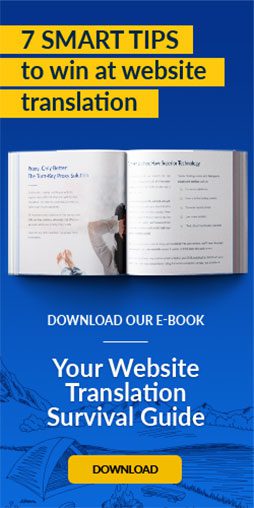Translating a website can’t be all that hard, can it? You just hire a few employees who speak the language and have them do it, right?
Unfortunately, it’s not that simple. To reach today’s digitally-savvy global consumers, you need to translate content quickly, accurately and authentically. And that’s just the beginning.
Building an efficient and effective website translation process can be tricky, but there are ways to ease the pain. Today’s best-in-class approaches give you authentic translations that effectively represent your brand while minimizing operational complexities and costs.
Here’s what to look for.
A Scalable, Turn-Key Solution
While there are many different approaches to localizing content, many are fraught with challenges:
- Translating only part of your website can give global customers the impression you’re not fully invested in a market or their satisfaction.
- Building a great in-house team requires expensive investments in employees and workflows.
- Some technology solutions, like CMS connectors, can “break” if you change your back-end systems.
Today’s best translation solutions are nimble, scalable and turn-key. They can launch translated websites in 30 days or less. And they don’t bog down your current in-house team with added tasks.
Translators Who Know Your Industry and Target Markets
It’s not enough to speak your customers’ language; you must also communicate in ways that are culturally relevant to them. Great translations are both localized for global markets and tailored for your particular industry.
Look to partner with best-in-class vendors that:
- Employ vetted, professional linguists, native speakers and industry subject matter experts
- Comply with certified international translation standards
- Allow you to choose the members of your translation team
- Assign your brand a long-term team to deliver consistent translation voice and style
- Conduct rigorous QA audits
Translations That Fit Your Brand Voice and Values
Your translations must look, sound and feel consistently like your brand across all markets—otherwise, you may alienate the customers you’ve worked so hard to get. Great translated content also reflects your key brand values in culturally relevant ways, and builds trust among new audiences.
Great vendors don’t trust this process to chance. Instead, they ensure their translators are equipped with:
- A glossary that accurately represents your products and industry—and are optimized for local SEO
- A style guide that represents your localized brand voice and tone
- Examples of translated content for internal review and feedback
- QA auditing and client feedback to assure alignment with your brand preferences
Clear Communications with Your Vendor
As you look for translation vendors, don’t be afraid to communicate clearly what you want, and how you want it—brand voice, tone, style, messaging and anything else that matters to your brand.
Best-in-class vendors will happily work with you to meet your needs, and will welcome clear direction about your brand voice, the preferences of your customers, and the details that really set your company apart from others in your industry.
Look for a provider that treats you like a partner, and who encourages frequent, clear and specific communication about how best to convey your brand in a new market.
A Streamlined Process
One of the biggest challenges of big translation projects is that they can drive up operational complexities quickly … and sometimes unexpectedly. There are a host of issues to consider in a comprehensive translation initiative, such as:
- Optimizing SEO metadata, hreflang tags and keywords
- Handling translations for third-party apps, dynamic PDFs, social media channels and other areas beyond your website
- Localizing brochures, ads and other offline content that supports sales teams
Enlist a vendor that is capable not only of providing high-quality translations, but a streamlined process that minimizes room for error across all translation projects.
Leverage Advanced Technical Solutions
Machine translations and crowdsourced translations may be speedy, but they also deliver inconsistent translation quality. Old-school translation vendors use well-trained staff but are typically slow to produce results and can’t keep up with today’s digital landscape.
How do you handle the disconnect? Find a translation vendor that can do both. Today’s best-in-class vendors not only use great translators; they also deploy advanced technical solutions like proxies and APIs that seamlessly get along with any website technology you use, and continue to work if you make hardware or software changes.
The best solutions also use translation memory—a database of stored brand translations that have already been vetted and approved. This translated content can be used again and again throughout your localized site or for omnichannel use.
This approach keeps your brand voice consistent, helps ensure continuing quality, and helps prevent the cost and effort that comes with translating the same content multiple times.
Conclusion
Translating your website requires authentic, culturally relevant translations that are consistent with your brand messaging and appropriately reflect your industry. A well-translated site also helps your business meet regulatory standards that may apply in various global markets.
Look for a translation partner that offers you all the tools necessary—including the most advanced technology and superior human expertise—to provide global customers with the world-class, in-language experience they expect and deserve.
Last updated on June 04, 2018